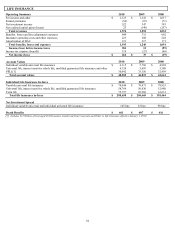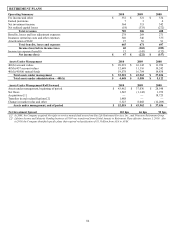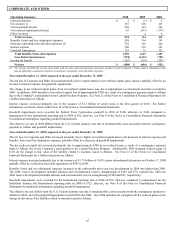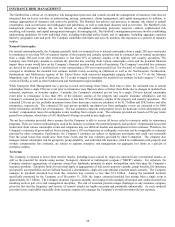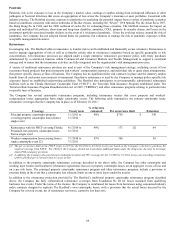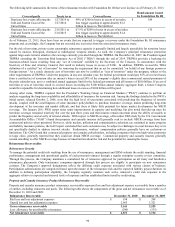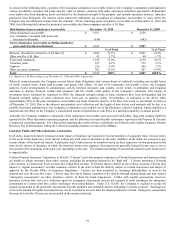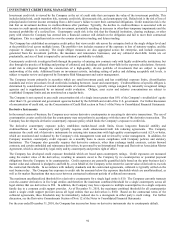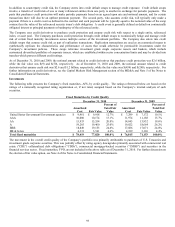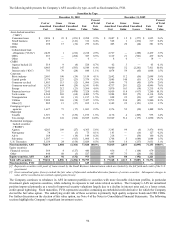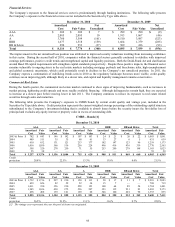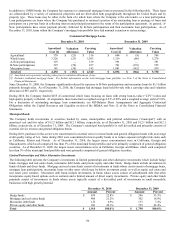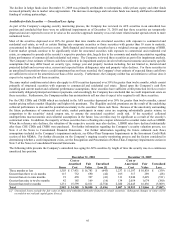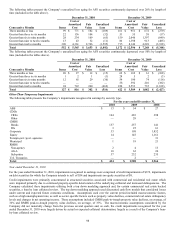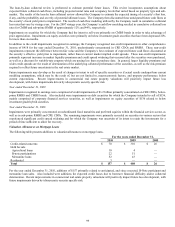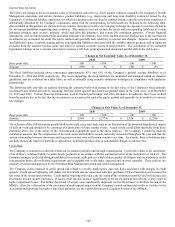The Hartford 2010 Annual Report Download - page 92
Download and view the complete annual report
Please find page 92 of the 2010 The Hartford annual report below. You can navigate through the pages in the report by either clicking on the pages listed below, or by using the keyword search tool below to find specific information within the annual report.
92
INVESTMENT CREDIT RISK MANAGEMENT
Investment credit risk is viewed by the Company as the set of credit risks that can impair the value of the investment portfolio. This
includes default risk, credit transition risk, systemic credit risk, idiosyncratic risk, and counterparty risk. Default risk is the risk of loss of
principal and/or interest income stemming from a debt issuer’ s failure to meet their contractual obligations. Credit transition risk is the
risk that an investment declines in creditworthiness after purchase. Typically, the decline in creditworthiness is associated with an
increase in credit spreads associated with the investment, potentially resulting in increases in other-than-temporary impairments and the
increased probability of a realized loss. Counterparty credit risk is the risk that the financial institution, clearing exchange, or other
party with whom the Company has entered into a financial contract will default on the obligation and fail to meet their contractual
obligations. This is a significant risk in over-the-counter derivatives trading, and futures trading.
The Company has established an enterprise credit policy that views credit risk across the enterprise both at the single obligor level and
at the portfolio level across multiple lenses. The portfolio view includes measures of the exposure to loss of statutory surplus, and the
exposure to changes in economy. The single obligor measures are also aggregated across the enterprise, and include exposures
generated from the investment portfolio, the insurance and reinsurance businesses, and any collateral short-falls. Limits are set
prudentially, and size of limit is impacted by an institution’ s probability to default.
Counterparty credit risk is mitigated both through the practice of entering into contracts only with highly creditworthy institutions, but
also through the practice of holding and posting of collateral, and including collateral short-falls in the exposure calculations. Systemic
credit risk is mitigated through the construction of a high-quality, diverse portfolio of investments that are subject to regular
underwriting of the risks. Additional limits on investment activity, including setting of policy and defining acceptable risk levels, is
subject to regular review and approval by Enterprise Risk Management and senior management.
The Company invests primarily in securities which are rated investment grade and has established exposure limits, diversification
standards and review procedures for all credit risks including borrower, issuer and counterparty. Creditworthiness of specific obligors is
determined by consideration of external determinants of creditworthiness, typically ratings assigned by nationally recognized ratings
agencies and is supplemented by an internal credit evaluation. Obligor, asset sector and industry concentrations are subject to
established Company limits and are monitored on a regular basis.
The Company is not exposed to any credit concentration risk of a single issuer greater than 10% of the Company’ s stockholders’ equity
other than U.S. government and government agencies backed by the full faith and credit of the U.S. government. For further discussion
of concentration of credit risk, see the Concentration of Credit Risk section in Note 5 of the Notes to Consolidated Financial Statements.
Derivative Instruments
In the normal course of business, the Company uses various derivative counterparties in executing its derivative transactions. The use of
counterparties creates credit risk that the counterparty may not perform in accordance with the terms of the derivative transaction. The
Company has developed a derivative counterparty exposure policy which limits the Company’ s exposure to credit risk.
The derivative counterparty exposure policy establishes market-based credit limits, favors long-term financial stability and
creditworthiness of the counterparty and typically requires credit enhancement/credit risk reducing agreements. The Company
minimizes the credit risk of derivative instruments by entering into transactions with high quality counterparties rated A2/A or better,
which are monitored and evaluated by the Company’ s risk management team and reviewed by senior management. In addition, the
Company monitors counterparty credit exposure on a monthly basis to ensure compliance with Company policies and statutory
limitations. The Company also generally requires that derivative contracts, other than exchange traded contracts, certain forward
contracts, and certain embedded and reinsurance derivatives, be governed by an International Swaps and Derivatives Association Master
Agreement, which is structured by legal entity and by counterparty and permits right of offset.
The Company has developed credit exposure thresholds which are based upon counterparty ratings. Credit exposures are measured
using the market value of the derivatives, resulting in amounts owed to the Company by its counterparties or potential payment
obligations from the Company to its counterparties. Credit exposures are generally quantified daily based on the prior business day’ s
market value and collateral is pledged to and held by, or on behalf of, the Company to the extent the current value of derivatives exceeds
the contractual thresholds. In accordance with industry standards and the contractual agreements, collateral is typically settled on the
next business day. The Company has exposure to credit risk for amounts below the exposure thresholds which are uncollateralized, as
well as for market fluctuations that may occur between contractual settlement periods of collateral movements.
The maximum uncollateralized threshold for a derivative counterparty for a single legal entity is $10. The Company currently transacts
over-the-counter derivatives in five legal entities and therefore the maximum combined threshold for a single counterparty across all
legal entities that use derivatives is $50. In addition, the Company may have exposure to multiple counterparties in a single corporate
family due to a common credit support provider. As of December 31, 2010, the maximum combined threshold for all counterparties
under a single credit support provider across all legal entities that use derivatives is $100. Based on the contractual terms of the
collateral agreements, these thresholds may be immediately reduced due to a downgrade in either party’ s credit rating. For further
discussion, see the Derivative Commitments Section of Note 12 of the Notes to Consolidated Financial Statements.
For the year ended December 31, 2010, the Company has incurred no losses on derivative instruments due to counterparty default.


